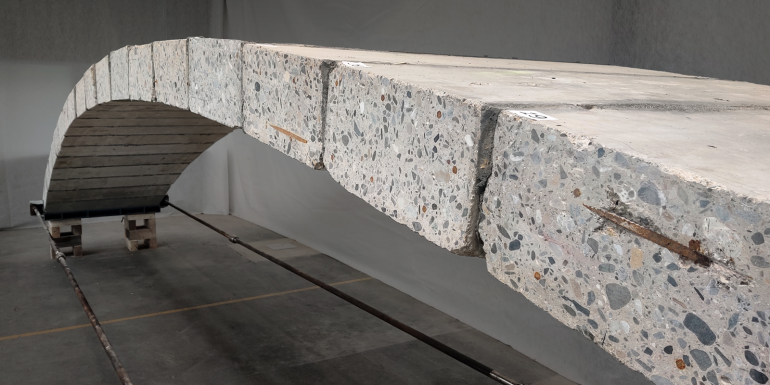Ahead of the curve

IStructE’s Will Arnold and Patrick Hayes have a plan for reducing embodied carbon and material reuse that may feel like a bold vision of the future, but it is achievable, notes Denise Chevin.
When it comes to net zero and the built environment, structural engineers are on the front line. Reducing the carbon emissions from buildings not only means designing them to use as little energy as possible, but also minimising the embodied carbon – that is the carbon emitted from the energy and chemical processes involved in extracting, manufacturing, delivering, installing and disposing of materials at the end of their life. As the amount of energy used in the operation of buildings reduces, cutting the embodied carbon – which can be 20-50% of the total carbon emitted over their lifetime – is a vital part of meeting the net-zero challenge.
In a typical new office building, the structure represents over half of the initial embodied carbon, which is why structural engineers are central players in tackling this challenge. And as the Institution of Structural Engineers (IStructE) points out, the concrete and constructional steel industries combined make up around 11% of all global emissions. With the structure of a building typically comprising just two or three materials, focusing on decarbonising these few pieces allows large carbon savings to be made very quickly.
IStructE sees the solution as a two-pronged approach. The first approach is to drive for new regulation that will create a level playing field by ensuring that all developers and their teams must reduce embodied carbon. The second is to help engineers through this carbon-first way of thinking by providing the knowledge and guidance to help reduce embodied carbon in structures and spearhead research that will deliver much-needed low-carbon materials.
IStructE is one of several industry bodies to put its name to the declaration of a climate and biodiversity emergency while pledging to advocate for faster change in the industry, including adopting regenerative design practices and sharing knowledge and research openly.

The RE:CREATE bridge has been created from reinforced concrete blocks, which were taken from a building due to be demolished
Part Z
The vehicle IStructE has proposed for mandating embodied carbon reduction is an amendment to the Building Regulations called Part Z (part-z.uk). Will Arnold, IStructE’s Head of Climate Action, was one of the main authors and has been campaigning for the government to adopt it. The proposed Building Regulations amendment Part Z and proposed Approved Document Z outline requirements on the assessment of whole-life carbon emissions and the limiting of embodied carbon emissions for all major building projects. Arnold says: “We are suggesting it’s introduced in two phases. The first part of the proposal introduces mandatory assessments ahead of a second stage, at least 18 months later, which entails setting carbon limits. This would again be in staged targets. This would allow for time to converge on robust yet ambitious targets.”
The proposal, which would start to reduce embodied carbon in buildings ahead of 2030, has received widespread support from across the industry, says Arnold, with many big names behind it. These include blue chip developers such as Lendlease and Landsec, and contractors Morgan Sindall and Laing O’Rourke.
But how much traction is Part Z receiving among the government and its officials? Since its campaign launch in Westminster in March 2022 – attended by a number of MPs, peers and civil servants – awareness and support are gathering momentum in Whitehall, says Arnold. Duncan Baker, the Conservative MP for North Norfolk, had already introduced a Private Members’ Bill to introduce reporting and subsequent limits on embodied carbon on all major building projects. This was subsequently picked up by Jerome Mayhew MP following the launch and was debated in parliament in late 2022. The Environmental Audit Committee’s report on the sustainability of the built environment, Building to net zero: costing carbon in construction, also underscored the importance of measuring and limiting embodied carbon in construction.
“There have been 49 mentions of embodied carbon in parliamentary debates since the launch of Part Z. The Department of Levelling up, Housing and Communities (DLUHC) has this year commissioned research around embodied carbon and the recommendations we’ve set out in Part Z,” says Arnold. “There has certainly been significant movement on this. I don’t think the introduction of regulation is a case of if, but when.”
For IStructE Technical Director Patrick Hayes, the campaign for Part Z is also about raising awareness across the sector about the need to consider and reduce embodied carbon and clearly set out the industry’s reasoning behind it.
Certainly, the idea of reducing the carbon footprint of new developments would appear to have the backing of DLUHC’s Secretary of State Michael Gove. He stunned developers and planners earlier this year when he turned down a decision to grant Marks & Spencer planning permission for the demolition and redevelopment of its Oxford Street store in London on the grounds of heritage and environmental concerns.
Gove’s reasoning extended to the embodied carbon impact and construction waste involved in the plan, pointing out that the construction of the new build replacement would “impede the UK’s transition to a zero-carbon economy”. Marks & Spencer is currently appealing the decision. However, some see Gove’s decision as a watershed that will drive more reuse of buildings to reduce embodied carbon.
To build or not to build
IStructE is itself promoting a hierarchy of net-zero design to reduce carbon emissions. In short, this means using less by questioning the need to build, reusing where possible and maximising space utilization. Then, if you must build, do so in a more carbon-efficient way through lean design and specifying low-carbon materials and prefabricated components to reduce waste. As a last resort, use carbon offsetting.
This lean design also requires a rigorous approach. “The safety factors in our codes are predicated on the assumption that both design and construction are checked – and this, rather than overdesign, needs to be the basis of achieving safety,” says Hayes.
It is not an easy task. Reusing materials and designing for reuse by making structures easier to dismantle and repurpose requires a different mindset and new skills. “We’re trying to encourage universities to include the topic in their courses,” Hayes adds.
To refine structural designs to be more efficient, there also needs to be an increased focus on manufacturing and installation quality. A ‘leaner’ structure will normally have lower levels of structural redundancy, so it becomes more important that it is built absolutely on spec.
In July this year, IStructE produced a new guide, Circular economy and reuse: guidance for designers. The four-part document explains how to overcome barriers to adoption, develops the thinking around reusing components and assemblies, and covers the circular economy principles to be used when designing new builds. It also touches on potential legal considerations. The document includes a chapter on resource-led design or “designing with what is available” – which it says structural engineers will need to develop to transition to a fully circular world.
There is growing interest in the circular economy, says Arnold. “It’s very real.” He points to a burgeoning market in reused steel components, with London developers such as Grosvenor leading the trend. The reusing of steel components in buildings was identified in the Skidmore review Mission Zero, published in January 2023, which set out the opportunities for industry in the journey to net zero.
While steel is an obvious contender for reuse because it is easier to dismantle than concrete slabs, concrete reuse should not be ruled out. Arnold points to a footbridge in Switzerland that was built with recycled concrete (see Recycling concrete).
Hayes says: “The codes that underpin the design of structures are also adapting to put sustainability at their heart, and in some cases reduce load factors that can still produce the same levels of safety. We’re actively promoting that.” Helpfully, Model Code 2020 is to be published this year and will include the assessment of existing concrete structures, encouraging reuse and adaption and therefore supporting the long-life argument for concrete structures.
Hayes says that vital to success are new digital tools that can measure carbon accurately in existing buildings. IStructE has been working with the Royal Institution of Chartered Surveyors (RICS) on its embodied carbon methodology. “But what we realised is that digital tools like this are set up for new buildings. We need tools that can survey and analyse carbon in existing buildings as well,” he says.
“But in terms of designing for reuse, we are quite clear that we are advocating lean and efficient designs for today, rather than designing for reuse in ways that might use more material and raise the embodied carbon.”
There is a great deal of work going on to make the reuse of materials more viable, particularly in terms of giving those looking to reuse the material more information and reassurance about its properties and therefore its safety. To this end, IStructE is working with the University of Sheffield and design firm ORMS to develop material passports, which organise and store data digitally about materials contained within a building. The basis of the idea is that if designers are equipped with useful information about the original specification and life history of an element, they have a better chance of deciding if it is suitable for reuse. As ORMS sets it out, the strategy centres on a material database, with material passports acting as a user interface to filter relevant information. The team is looking to develop an open-source methodology for existing buildings that would be accessible to all design teams.

Recycling concrete
A 10m RE:CRETE bridge, developed by researchers at science and technology institute EPFL in Switzerland, incorporates reinforced concrete blocks taken from the walls of a local building that was being demolished.
The footbridge is made up of 25 blocks that were cut into individual pieces on-site, transported to the Smart Living Lab at the EPFL campus in Fribourg and assembled into a pre-stressed arch.
The project, claimed to be the first of its type, was undertaken by researchers in late 2021 to demonstrate how reclaimed materials could form the basis of entire buildings. It has been reported that the comparative life-cycle assessment of the bridge – covering materials’ manufacture, disassembly and reassembly processes and transport – revealed approximately the same greenhouse gas emissions as a glulam timber arch built to the same span and to withstand the same loads.
Materials and innovation
While work is ramping up on reuse, structural engineers are hoping that at the same time the development of genuine low-carbon materials will accelerate, given the Intergovernmental Panel on Climate Change says that we must halve global emissions by 2030 if the Earth’s temperature is to keep within the 1.5°C increase. Both Arnold and Hayes play down the impact that low-carbon steels and cements have currently on reducing carbon emissions.
“The majority of these technologies rely on substituting primary steel and primary cement with scrap steel and cement replacements (typically waste by-products from coal-powered industries). This is great in theory, except that globally we consume three times as much steel as exists in scrap form, and eight times as much cement as exists in replacements.”
Arnold says that when selecting such materials, designers are probably moving limited resources from elsewhere in the world, so they are not reducing global emissions. Both argue that industry, academia and institutions must work together to crack the problem.
The use of structural timber, seen as a greener alternative to steel and concrete, is no holy grail either, according to Hayes. It goes without saying it needs to be sustainably sourced, but there are fire issues that need more research and investigation, and it would also mean increasing forestation. “As little as 25% of a tree can go into making structural timber, so we need to ensure that the other 75% is not adding to carbon emissions,” he says. Hayes highlights a couple of innovations that represent exciting breakthroughs in reducing emissions on a bigger scale. One is the development of electric arc furnacing. This technique uses electric power rather than fossil fuels in the steel manufacturing process. Tata Steel and the UK government have announced a joint agreement on a proposal to invest in state-of-the-art electric arc furnace steelmaking at the Port Talbot site in Wales with a capital cost of £1.25bn, including a government grant of up to £500m. The plant is expected to reduce the UK’s emissions by 50 million tonnes over a decade. Arnold adds that “electric arc furnaces are a stepping stone towards green hydrogen-based primary steel production”.
Another exciting development Hayes points to is calcined clay cement, which uses a type of clay found in abundance as part of the mix, resulting in as much as a 30% reduction in the carbon footprint of the cement. Cement manufacturer Holcim has recently announced the first manufacturing plant in Europe to produce this type of cement at scale.
Though there is clearly a long way to go, Hayes is optimistic about the role structural engineers and the industry are playing in moving to net zero. “Developers are being driven to reduce carbon in their buildings by environmental, social and governance (ESG) funding, and to attract tenants and employees who want to work in highly sustainable buildings. Engineers themselves see they have a social responsibility and are motivated to design in ways that pull us forward to net zero.
“But if we want to make it business as usual, there is nothing like legislation to drive the agenda forward. That is why we think Part Z is so important to ensure that clients take this approach. If we take an incremental approach to carbon limits, the transition to reduce embodied carbon should be affordable.”
For more, visit istructe.org
IStructE’s Technical Director Patrick Hayes will be speaking at Built Environment LIVE in December. Visit bit.ly/CABE_LIVE23 to book your free place.










